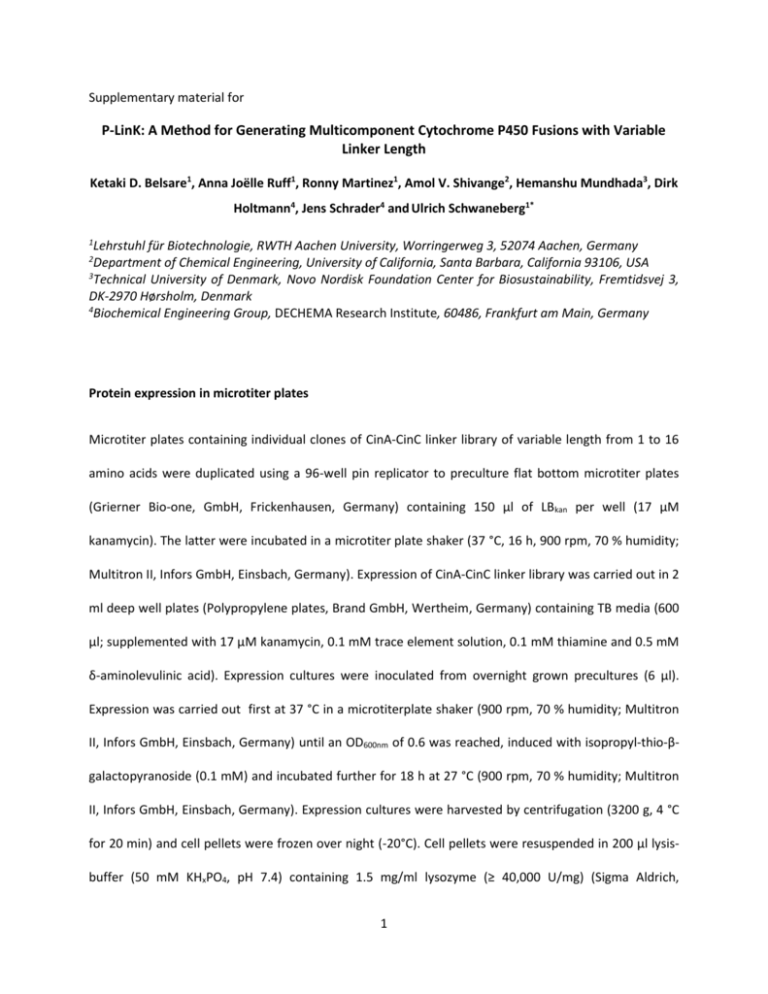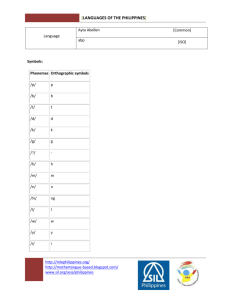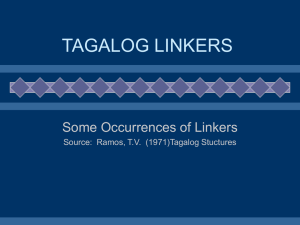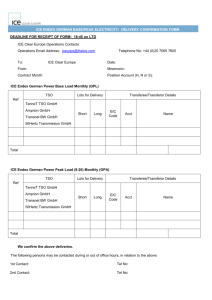Supplementary material for P-LinK: A Method for Generating
advertisement

Supplementary material for P-LinK: A Method for Generating Multicomponent Cytochrome P450 Fusions with Variable Linker Length Ketaki D. Belsare1, Anna Joëlle Ruff1, Ronny Martinez1, Amol V. Shivange2, Hemanshu Mundhada3, Dirk Holtmann4, Jens Schrader4 and Ulrich Schwaneberg1* 1 Lehrstuhl für Biotechnologie, RWTH Aachen University, Worringerweg 3, 52074 Aachen, Germany Department of Chemical Engineering, University of California, Santa Barbara, California 93106, USA 3 Technical University of Denmark, Novo Nordisk Foundation Center for Biosustainability, Fremtidsvej 3, DK-2970 Hørsholm, Denmark 4 Biochemical Engineering Group, DECHEMA Research Institute, 60486, Frankfurt am Main, Germany 2 Protein expression in microtiter plates Microtiter plates containing individual clones of CinA-CinC linker library of variable length from 1 to 16 amino acids were duplicated using a 96-well pin replicator to preculture flat bottom microtiter plates (Grierner Bio-one, GmbH, Frickenhausen, Germany) containing 150 µl of LBkan per well (17 µM kanamycin). The latter were incubated in a microtiter plate shaker (37 °C, 16 h, 900 rpm, 70 % humidity; Multitron II, Infors GmbH, Einsbach, Germany). Expression of CinA-CinC linker library was carried out in 2 ml deep well plates (Polypropylene plates, Brand GmbH, Wertheim, Germany) containing TB media (600 µl; supplemented with 17 µM kanamycin, 0.1 mM trace element solution, 0.1 mM thiamine and 0.5 mM δ-aminolevulinic acid). Expression cultures were inoculated from overnight grown precultures (6 µl). Expression was carried out first at 37 °C in a microtiterplate shaker (900 rpm, 70 % humidity; Multitron II, Infors GmbH, Einsbach, Germany) until an OD600nm of 0.6 was reached, induced with isopropyl-thio-βgalactopyranoside (0.1 mM) and incubated further for 18 h at 27 °C (900 rpm, 70 % humidity; Multitron II, Infors GmbH, Einsbach, Germany). Expression cultures were harvested by centrifugation (3200 g, 4 °C for 20 min) and cell pellets were frozen over night (-20°C). Cell pellets were resuspended in 200 µl lysisbuffer (50 mM KHxPO4, pH 7.4) containing 1.5 mg/ml lysozyme (≥ 40,000 U/mg) (Sigma Aldrich, 1 Taufkrichen, Germany) and cell lysis was subsequently performed in a microtiter plate shaker (37 °C, 1 h; 900 rpm, 70 % humidity; Multitron II, Infors GmbH, Einsbach, Germany). Clear supernatants were obtained by centrifugation (3200 g, 4 °C for 20 min) and used subsequently for SDS-PAGE analysis, CObinding measurements, and 1,8-cineole conversions. Protein expression in flasks (CinA, CinC and CinA-CinC fusion protein) Preculture was grown in LBkan medium (4 ml, 37 °C, 16 h, 250 rpm, 17 µM kanamycin). Expression culture (400 ml, TB media supplemented with 17 µM kanamycin, 0.1 mM trace element solution, 0.1 mM thiamine and 0.5 mM δ-aminolevulinic acid (except for CinC)) was inoculated with 1% preculture and incubated first at 37 °C (250 rpm, 70 % humidity, Infors HT, Minitron, Einsbach, Germany) until an OD600nm of 0.6 was reached, induced with isopropyl-thio-β-galactopyranoside (0.1 mM) and incubated further for 18 h at 27 °C (250 rpm, 70 % humidity, Infors HT, Minitron, Einsbach, Germany). Expression cultures were harvested by centrifugation (3200 g, 4 °C for 20 min) and cell pellets were frozen overnight (-20°C). All following steps were performed on ice unless otherwise specified. Cell pellets from 400 ml expression culture were resuspended in 25 ml of cold (4 °C) loading buffer (50 mM Tris-HCl buffer, pH 7.8 for CinA and CinA-CinC fusion proteins; 50 mM Tris-HCl, 50 mM KCl pH 7.4 for CinC). Resusupension was performed by sonication (40 % amplitude, 30 sec x 4 cycles; SONICS Vibra cell VCX-130, Zinsser Analytics, Frankfurt, Germany) followed by cell lysis using high pressure homogenation (3 cycles; 1500 bar EmulsiFlux C3, Avestin Europe GmbH). Disrupted cells were centrifiged (3200 g, 4 °C for 30 min) and the supernatant obtained was further filtered through a polyvinylidene difluoride filter (0.45 µm; Ministart RC 25 disposable syringe filters; Sartorius, Hamburg, Germany). The cleared lysate was used for purification. Protein purification 2 Purification of CinA-CinC fusion proteins and CinA was performed using ÄKTA prime plus protein purification system (GE Healthcare, München, Germany) on preparative LC columns (internal diameter 15 mm, length 125 mm; KRONLAB Glass Columns, TAC 15/125 PE5-AB-2, YMC Europe GmbH, Dinslaken) by anion exchange chromatography using Toyopearl 650S-DEAE matrix (Tosoh Biosciences, Tokyo, Japan) (bed size: 15 mm x 110 mm). Column was equilibrated in loading buffer (20 CVs; 50 mM Tris-HCl buffer, pH 7.8, flow rate 3 ml/min). The filtered and clarified lysate (25 ml) was loaded on the column (flow rate 1 ml/ min) and unbound protein was washed out with loading buffer (20 CVs, flow rate 1.5 ml/min). Protein was eluted by salt gradient (1 M NaCl, 50 mM Tris-HCl buffer, pH 7.8, gradient from 0% to 40 % in 200 ml, flow rate 1.5 ml/min). Purity was checked by SDS-PAGE (12 % SDS-gel; 20 mA, 50 W, 80 min; Mini-Protean Tetra Cell, Bio-Rad Laboratories GmbH, München Germany). Expected sizes for CinA is 45 kDa and for CinA-CinC fusion protein 61 kDa. Purified protein was concentrated using 10K Amicon Ultra-4 filters (Darmstadt, Germany) and subsequently desalted using PD-10 desalting columns with 50 mM KHxPO4 buffer (Matrix: SephadexTM G- 25- 5 ml; GE-healthcare, USA). Next, the desalted protein was lyophilized for 18 h (Christ Alpha 1-2 LD Plus; Omnilab laborzentrum GmbH & Co. KG, Germany) and stored at -20 °C. Purification of CinC was performed by anion exchange chromatography using Toyopearl 650S-DEAE matrix (Tosoh Biosciences, Tokyo, Japan) (bed size: 15 mm x 110 mm) like described for CinA with the following modifications. Column was equilibrated in loading buffer (20 CVs; 50 mM Tris-HCl, 50 mM KCl pH 7.4, flow rate 3ml/min). Subsequently, the filtered and clarified lysate (25 ml) was loaded on the column (flow rate 1 ml/min) and unbound protein was washed out with loading buffer (20 CVs, flow rate 1.5 ml/min). CinC was eluted using salt gradient (1 M KCl, 50 mM Tris-HCl, pH 7.4, gradient from 0% to 40 % in 200 ml, flow rate 1.5 ml/min). Purified CinC was concentrated using 3K Amicon Ultra-4 filters (Darmstadt, Germany) and subsequently purified by a second size exclusion chromatrography step using G-Sephadex matrix (bed volume: 15 mm x 110 mm, pore size: 100-300 µM; Sigma Aldrich, Taufkrichen, 3 Germany) using a preparative LC column (internal diameter 15 mm, length 125 mm; KRONLAB Glass Columns, TAC 15/125 PE5-AB-2, YMC Europe GmbH, Dinslaken). The column was equilibrated (20 CVs, 50 mM Tris- HCL, pH 7.4, flow rate 3 ml/min) and pooled fractions containing CinC obtained after first purification step were loaded (flow rate 1 ml/min). CinC was eluted in buffer (50 mM Tris-HCl, pH 7.4; flow rate 1.5 ml/min, fraction size 1 ml). Purity was checked by SDS-PAGE like described above for CinA. The expected size of CinC is 16 kDa. Additionally, the purity was monitored by UV spectroscopy at 456 nm. Purified CinC was subsequently desalted in a third purification step using PD-10 desalting columns with 50 mM KHxPO4 buffer (Matrix: SephadexTM G- 25- 5 ml; GE-healthcare, USA). Finally, the desalted protein was lyophilized for 16 h (Christ Alpha 1-2 LD Plus; Omnilab laborzentrum GmbH & Co. KG, Germany) and stored at -20 °C. Expression and Purification of Fpr Expression of E.coli flavodoxin reductase (Fpr) was performed as described above for expression of CinA and CinC with the following modification. The expression culture (400 ml, TB media supplemented with 17 µM kanamycin, 0.1 mM trace element solution, 1 mM MgCl2, 5 mM NaCl) was incubated at 33 °C (250 rpm, 70 % humidity, Infors HT, Minitron, Einsbach, Germany) until an OD600nm of 0.6 was reached, induced with isopropyl-thio-β-galactopyranoside (0.1 mM) and incubated for further 4 h at 33 °C (250 rpm, 70 % humidity, Infors HT, Minitron, Einsbach, Germany). Expression culture was harvested like described above for Cin A and pellet of expressed Fpr was resuspended in 25 ml of cold (4 °C) loading buffer (50 mM Tris- HCl, 200 mM NaCl, 1 mM dithiothreitol, 0.1 mM phenylmethanesulfonyl fluoride, pH 7.4). The clear cell lysate was prepared as described above for CinA. Purification of Fpr was performed as previously reported with the following modification to the protocol of Hawkes et al (1,2). Fpr was purified by two anion exchange chromatography steps. In the first step, using Toyopearl 650S-DEAE matrix (Tosoh Biosciences, Tokyo, Japan, bed size: 15 mm x 110 mm) and ÄKTA prime plus protein purification system (GE Healthcare, München, Germany) on a preparative LC 4 columns (internal diameter 15 mm, length 125 mm; KRONLAB Glass Columns, TAC 15/125 PE5-AB-2; YMC Europe GmbH, Dinslaken). Column matrix was equilibrated in loading buffer (20 CVs; 50 mM TrisHCl; pH 7.4, flow rate 3 ml/min). The filtered and clarified lysate (25 ml) was loaded on the column (flow rate 1 ml/min) and unbound protein was washed out with loading buffer (20 CVs, flow rate 1.5 ml/min). Protein was eluted by salt gradient in elution buffer (1 M NaCl, 50 mM Tris-HCl, pH 7.4, gradient from 0% to 40 % in 200 ml, flow rate 1.5 ml/min). Purity was checked by SDS-PAGE after each chromatography step (12 % SDS-gel; 20 mA, 50 W, 75 min; Mini-Protean Tetra Cell, Bio-Rad Laboratories GmbH, München Germany). Expected size for Fpr is 29 kDa. Fractions containing Fpr were pooled and purified by a second chromatography step using Toyopearl HW-55F column (Tosoh Biosciences LLC, Tokyo, Japan; bed volume: 15 mm x 100 mm) and LC columns (internal diameter 15 mm, length 125 mm; KRONLAB Glass Columns, TAC 15/125 PE5-AB-2, YMC Europe GmbH, Dinslaken). Column was equilibrated in loading buffer (20 CVs; 50 mM Tris-HCl; pH 7.4, flow rate 3 ml/min). Pooled fractions containing Fpr obtained after first purification step were loaded on the column (flow rate 1 ml/min) and unbound protein was washed out using loading buffer (20 CVs, 50 mM Tris-HCl; pH 7.4, flow rate 1.5 ml/min). Fpr was eluted by salt gradient (1 M NaCl, 50 mM Tris-HCl, pH 7.4, gradient 0 to 40 % in 200 ml, flow rate 1.5 ml/min). Purity was checked by SDS-PAGE after each chromatography step (12 % SDS-gel; 20 mA, 50 W, 75 min; Mini-Protean Tetra Cell, Bio-Rad Laboratories GmbH, München Germany). Expected size for Fpr is 29 kDa. Purified Fpr was subsequently desalted in a third purification step using PD-10 desalting column with 50 mM KHxPO4 buffer (Matrix: SephadexTM G- 25- 5 ml; GE-healthcare, USA). Finally, the desalted protein was lyophilized for 18 h (Christ Alpha 1-2 LD Plus ; Omnilab laborzentrum GmbH & Co. KG, Germany) and stored at -20 °C. Determination of Protein concentration 5 Concentration of active P450 in purified CinA and CinA-CinC fusion proteins was determined by CO differential spectroscopy as described (3). Concentration of CinC and E.coli flavodoxin reductase (Fpr) was determined as reported previously (4,5). Activity assay, coupling and gas chromatographic analysis Activity of CinA- linker-CinC fusion protein library was determined in 96-well microtiter plate format using crude cell lysate (prepared as mentioned in the section protein expression in microtiter plates) and automated TLC for semi-quantifying 2-β-hydroxy-1,8-cineole production. E. coli Fpr was supplemented in all reaction mixtures and NADPH was used as reduction equivalent. The final reaction mixtures (50 mM KHxPO4, pH 7.4; 0.25 ml MTP format) contained CinA-linker-CinC fusion protein variant (1 µM), Fpr (1 µM), 1,8-cineole (6 mM) and catalase (1500 U; Catalase from bovine liver, Sigma Aldrich, Taufkrichen, Germany). Reactions were initiated by supplementing NADPH (0.4 mM final concentration) and incubated for 2 h at 30° C in microtiter plate shaker (900 rpm, 70 % humidity; Multitron II, Infors GmbH, Einsbach, Germany). Reaction product was extracted with 250 µl ethyl acetate containing 800 µM thymol as internal standard, dried over MgSO4, and 40 µl of extracted product was spotted on a precoated Silica gel 60 F 254 plates (20 cm x 10 cm; Merck KGaA, Darmstadt, Germany) using an automatic TLC sampler (CAMAG automated TLC sampler 4, Camag GmbH, Berlin Germany). A hexane/ethyl acetate (17:3) mixture was employed for TLC separation and a p-anisaldehyde/glacial acetic acid/91%H2SO4 (0.5:60:0.5) mixture was used for 2-β-hydroxy-1,8-cineole visualization after heat incubation (heat gun; 100-105° C). Densitometry evaluation of the TLC plates was carried out at a wavelength of 634 nm (TLC scanner 3, CAMAG GmbH; Berlin, Germany) and data analysis was performed with WinCATS software. The 32 most active variants and 15 inactive variants were selected for sequencing. Active CinA-CinC fusion variants (linker length > 5) were used for further activity measurements. 6 Activity measurements for purified CinA-linker-CinC fusion proteins (1 ml scale; 50 mM KHxPO4, pH 7.4; CinA-linker-CinC fusion protein variant (1 µM), Fpr (1 µM), 1,8-cineole (6 mM), catalase (1500 U), NADPH (0.4 mM)) were monitored by spectrophotometric measurement of NADPH depletion at 340 nm (Spectrophotometer Varian Cary 50 UV, Agilent Technologies, Darmstadt, Germany). The reaction product was extracted with ethyl acetate (1 ml) containing 800 µM thymol as internal standard and dried over MgSO4. Subsequently, the product amount was determined by Gas Chromatography (GC-2010, Schimadzu, Duisburg, Germany; column: 30 m x 0.25 µm x 0.25 mm, FS Supreme-5 ms from CSChromatographic Service, GmbH Langerwehe, Germany) with the following temperature program: from 80 °C to 150 °C with 5 °C /min (Injection volume: 1 µl, Split ratio: 20, carrier gas: nitrogen). The retention time of 2-β-hydroxy-1,8-cineole was determined to be 9.3 min. Coupling efficiency of CinA-CinC fusion proteins was determined by the following procedure. Reactions (1 ml scale; 50 mM KHxPO4, pH 7.4) contained CinA-CinC fusion proteins (1 µM), E.coli Fpr (1 µM), 1,8cineole (6 mM), catalase (1500 U) and were initiated by addition of NADPH (0.4 mM). NADPH depletion was monitored by spectrophotometric measurement at 340 nm (Spectrophotometer Varian Cary 50 UV, Agilent Technologies, Darmstadt, Germany). Reaction was stopped at 700 sec by addition of extraction solvent (1 ml) containing 800 µM thymol as internal standard and product concentration was determined by GC. The coupling efficiency (in percentage) was calculated as the ratio of NADPH used for substrate oxidation to the total amount of NADPH consumed by P450 in the reaction. 7 Figure 1. Coupling efficiency of CinA-CinC fusion proteins generated by P-Link versus linker length from 016 amino acids and unfused CinA+CinC+Fpr. The coupling efficiency (in percentage) was calculated as the ratio of NADPH used for substrate oxidation to the total amount of NADPH consumed by P450 in the reaction. Correlation between TLC assays and GC-FID measurements TLC screening was used as a pre-screen to differentiate between active and inactive clones using crude cell lysates and semi-quantify (in µM, with 50 µM approximation) the amount of 2-β-hydroxy-1,8-cineole formed. In the following experiments, GC-FID was used to accurately quantify the amount of 2-βhydroxy-1,8-cineole formed by each linker construct using purified enzyme. The correlation between TLC assays using crude cell lysates and GC analysis using purified fusion enzymes is shown in Figure 2. 8 Product [µM] Linker Length GC-FID TLC 6 88.34 100 7 102.03 100 8 116.12 100 9 140 150 10 176.67 200 11 12 13 14 15 154.26 128.17 95.54 105.61 105.49 150 150 100 100 100 16 105.64 100 Figure 2. Correlation between thin layer chromatography using crude extracts (lysate from 96-well microtiter plate expression) and GC analysis of reactions by purified fusion enzymes (P450 amount normalized to 1 µM). The screening using TLC was performed in a 96-well microtiter plate without normalizing the amount of P450 in the reaction whereas in case of purified enzymes, reactions were performed using normalized amount of P450 (1 µM). Figure 1, table on the right shows the amount of 2-β-hydroxy-1,8-cineole as calculated by TLC and GC-FID. Quantification using TLC assay could determine the amount of 2- βhydroxy-1,8-cineole only in steps of 50 µM and therefore it was necessary to use GC-FID for precise quantification of 2- β-hydroxy-1,8-cineole. As seen in figure 2, a good correlation was observed between detection of 2-β-hydroxy-1, 8-cineole using the TLC in the screening assay and GC-FID for mutant characterization. 1 2 3 4 5 6 7 8 9 10 11 12 13 14 15 16 17 18 19 20 Figure 3. An exemplary TLC plate as obtained with automated TLC in the screening assay. The samples were spotted with Automatic TLC sampler 4, developed using Automatic developing chamber (ADC 2 in n-hexane: ethyl acetate (17:3); stained with p-anisaldehyde: glacial acetic acid: concentrated H2SO4 9 (0.5:60:05) and scanned using TLC scanner 3. Lane 1-12: samples applied. Blue stop represent 2-βhydroxy-1, 8-cineole and orange spot represent thymol. Table 2. Oligonucleotides used in the study Primer Name Purpose Sequence FA1 RA1 FC1 RC1 FP1 RP1 cinA amplification cinA amplification cinC amplification cinC amplification Vector amplification Vector amplification RL1 FL1 FL2 FL3 FL4 FL5 R.P. for linkers 1-5 F.P. for Linker 1 F.P. for Linker 2 F.P. for Linker 3 F.P. for Linker 4 F.P. for Linker 5 ttcgctcagacgTTTGCCTTTCGGAAAAATAATC cgtctgagcgaaCCTATGGGTAATGCCCTGATTTTATATGGCAC cgtctgagcgaaCCTTCTATGGGTAATGCCCTGATTTTATATGGCAC cgtctgagcgaaCCTTCTCCAATGGGTAATGCCCTGATTTTATATGGCAC cgtctgagcgaaCCTTCTCCATCTATGGGTAATGCCCTGATTTTATATGGC cgtctgagcgaaCCTTCTCCATCTACTATGGGTAATGCCCTGATTTTATATGGC RL2 FL6 FL7 FL8 FL9 FL10 FL11 R.P. for linkers 6-11 F.P. for Linker 6 F.P. for Linker 7 F.P. for Linker 8 F.P. for Linker 9 F.P. for Linker 10 F.P. for Linker 11 agtagatggagaAGGTTCGCTCAGACGTTTGCCTTTC tctccatctactGACATGGGTAATGCCCTGATTTTATATGGCAC tctccatctactGACCAAATGGGTAATGCCCTGATTTTATATGGCAC tctccatctactGACCAATCCATGGGTAATGCCCTGATTTTATATGGCAC tctccatctactGACCAATCCCCTATGGGTAATGCCCTGATTTTATATGGCAC tctccatctactGACCAATCCCCTTCTATGGGTAATGCCCTGATTTTATATG tctccatctactGACCAATCCCCTTCTACTATGGGTAATGCCCTGATTTTATATG RL3 FL12 FL13 FL14 FL15 FL16 R.P. for linkers 12-16 F.P. for Linker 12 F.P. for Linker 13 F.P. for Linker 14 F.P. for Linker 15 F.P. for Linker 16 agtagaaggggaTTGGTCAGTAGATGGAGAAGGTTCGCTCAGACGTTTGCC tccccttctactGGAATGGGTAATGCCCTGATTTTATATGGCAC tccccttctactGGAGACATGGGTAATGCCCTGATTTTATATGGCAC tccccttctactGGAGACGCTATGGGTAATGCCCTGATTTTATATGGCAC tccccttctactGGAGACGCTGTTATGGGTAATGCCCTGATTTTATATG tccccttctactGGAGACGCTGTTGCTATGGGTAATGCCCTGATTTTATATG gactcactatagGGGAATTGTGAGCGG ttcgctcagacgTTTGCCTTTCGG cgtctgagcgaaATGGGTAATGCCCTGATTTTATATGGC cgggctttgttagCAGCCGGATCTCAG ctaacaaagcccgAAAGGAAGCTGAGTTG ctatagtgagtcGTATTAATTTCGAACATGTGAGC *Underlined bold letters represents phosphorothioated nucleotides 10 Table 3. Conversion of 1, 8-Cineole was performed using CinA-CinC fusion system supplemented with E.coli Fpr (1 µM) and NADPH (0.4 mM) as a reduction equivalent. Control reactions were performed using unfused CinA and CinC domains and empty vector pALXtreme-1a. (n.c. = no conversion detected) Construct/Enzyme CinA-CinC fusion CinA CinC CinA+ CinC Empty vector Active/Inactive Amount of 2-β-hydroxy,1,8cineole obtained (µM) Coupling (%) Inactive Inactive Inactive Active Inactive n.c. n.c. n.c. 315±13.88 n.c. n.c. n.c. n.c. 79±3.47 n.c. Table 4. The secondary structure predictions of the linkers using the Chou- Fasman parameters (http://www.biogem.org/tool/chou-fasman/). The percentage possibility for secondary structure of each linker sequence has been classified in Helix, Sheet and Turn. Linker BM3 linker First eight amino acids of P450 BM3 linker Last eight amino acids of P450 BM3 linker Last eight amino acids of designed linker New designed linker Sequence % possibility of sequence to form Helix 62.5 Sheet 0.0 Turn 25.0 0.00 0.00 37.5 AKKVRKKA 87.5 0.00 25.0 PSTGDAVA 0.00 0.00 12.5 PSPSTDQSPST GDAVA 0.0 0.0 25.0 PSPSTDQSAKK VRKKA PSPSTDQS References 1.Hawkes, D.B., K.E. Slessor, P.V. Bernhardt, and J.J. De Voss. 2010. Cloning, Expression and Purification of Cindoxin, an Unusual Fmn‐Containing Cytochrome P450 Redox Partner. ChemBioChem 11:1107-1114. 2.Jenkins, C.M. and M.R. Waterman. 1998. NADPH-flavodoxin reductase and flavodoxin from Escherichia coli: characteristics as a soluble microsomal P450 reductase. Biochemistry 37:61066113. 3.Omura, T. and R. Sato. 1964. The carbon monoxide-binding pigment of liver microsomes. I. Evidence for its hemoprotein nature. J biol Chem 239:2370-2378. 4.Aliverti, A., B. Curti, and M.A. Vanoni. 1999. Identifying and quantitating FAD and FMN in simple and in iron-sulfur-containing flavoproteins, p. 9-23. Flavoprotein protocols. Springer. 11 5.Macheroux, P. 1999. UV-visible spectroscopy as a tool to study flavoproteins, p. 1-7. Flavoprotein protocols. Springer. 12






